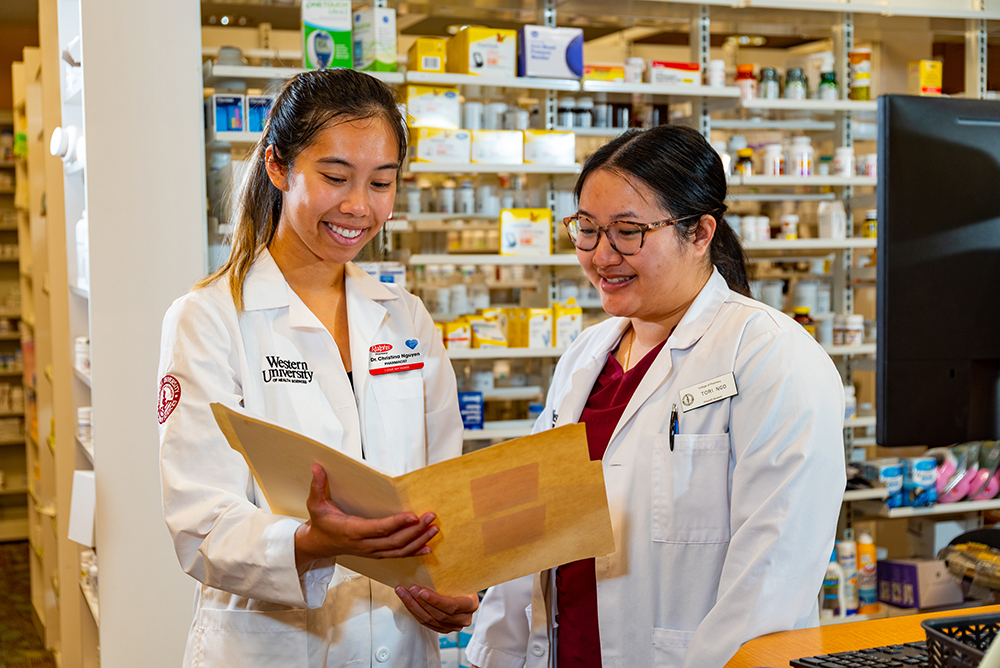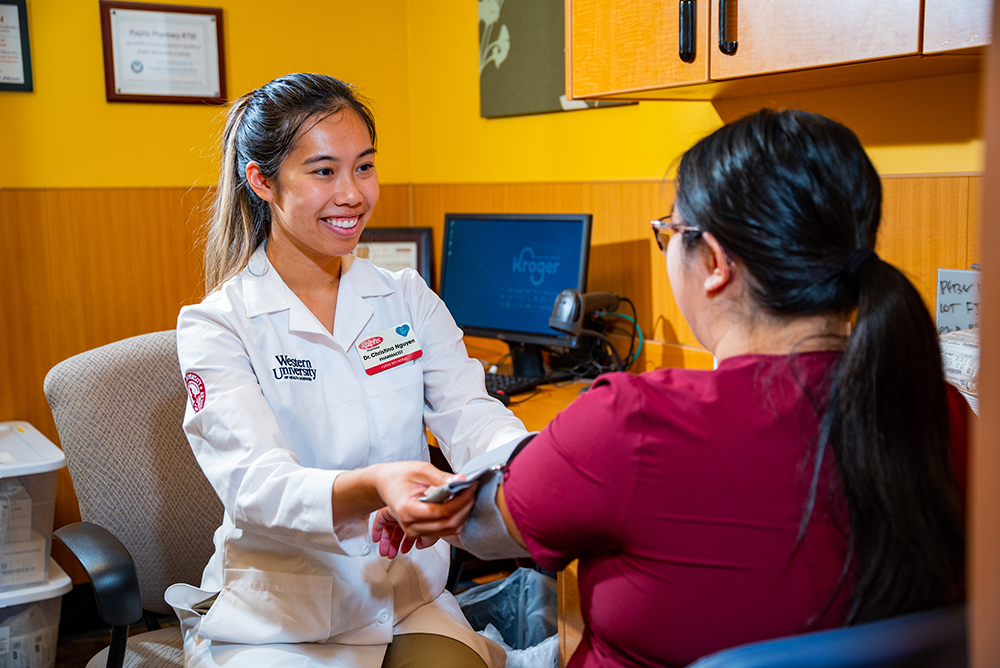Through a CPF/APhA Foundation grant, alum Christina Nguyễn explores pharmacists’ roles in screening social determinants of health
By Katie Ginder-Vogel
Christina Nguyễn (PharmD ’21) has always been passionate about public health and whole health — an approach that considers patients’ wellbeing, values, and goals in addition to their medical needs.
As a PharmD student at the University of Wisconsin–Madison School of Pharmacy, she worked for the Whole Health Initiative, a collaborative project among the UW–Madison Department of Family Medicine and Community Health and the William S. Middleton Memorial Veterans Hospital that aims to train healthcare providers to work with patients to consider the whole person when providing care.
“The idea is to shift focus from, ‘What is wrong with you?’ to ‘What matters to you?’ when we initiate healthcare conversations,” Nguyễn says.
After graduation, she joined the Western University of Health Sciences in Pomona, Calif., for a PGY-1 community-based residency program based at Ralphs Pharmacies, where she’s launched a new research project to extend that work.
“The idea is to shift focus from, ‘What is wrong with you?’ to ‘What matters to you?’ when we initiate healthcare conversations.”
—Christina Nguyễn
During her residency, Nguyễn was awarded a Community Pharmacy Foundation (CPF)/American Pharmacists Association (APhA) Foundation Incentive Grant for a project to pursue screenings for social determinants of health in community pharmacies. Her study aims to assess the utility of community pharmacist referrals in connecting patients with local resources that address social determinants of health.
Social determinants of health (SDOH) account for up to 80 percent of health outcomes, but only 16 percent of clinic practices and 24 percent of hospitals report screening their patients’ SDOH. That’s where Nguyễn’s project positions pharmacists to step in.
“My experience in pharmacy school and in working with the Whole Health Initiative pushed me to this mindset,” she says. “I’ve incorporated SDOH into everything I do.”
Screening for barriers
Community pharmacists, whom patients typically see every couple of months, are in a unique position to screen for SDOH and to provide patients with community resources to help them overcome SDOH-imposed barriers.
Nguyễn says pharmacies are convenient, embedded in patients’ communities, and patients visit them frequently. Pharmacists are available to answer questions almost immediately and see patients frequently enough to build rapport and trust.

“Evaluating patients’ SDOH as a screening service allows us, as pharmacists, to better understand our patients’ needs, implement solutions, and provide recommendations that ultimately improve the health of our communities,” says Nguyễn.
Screenings can identify barriers to care, like food and housing insecurity or transportation challenges. The existing literature addresses the implementation of SDOH screenings in pharmacies but lacks information on the success rate of the screenings in addressing patients’ barriers to care.
During Nguyễn’s project, she worked with all 76 Ralphs Pharmacies to understand patients’ utilization rates of resources after pharmacists provide them and to shed light on the correlation between patients’ social vulnerability index (SVI) and their potential barriers to care. SVI refers to the potential negative effects on a community caused by external stresses on health, with higher values equating to more negative effects.
She learned that more than a quarter of patients — 27 percent — self-identified with having SDOH barriers, particularly patients with a high SVI. Among patients found to have a high SVI, half of them faced one or more barriers to care. Among those with moderate SVI, 38.5 percent had at least one barrier to care. The Ralphs Pharmacists learned that the most common gap in care was affording healthcare, followed by support and transportation. These patients were then offered resources, such as patient assistance programs and FindHelp.org.
“As providers, we can only give full care if we know everything going on in patients’ lives. When we see them in the community pharmacy, we can’t expect patients to prioritize our goals — medication adherence — if they have food insecurity or lack transportation,” she says. “It all ties together, and if we want them to be healthy and at their best, we have to address their needs.”

Although only 20 percent of the high SVI group connected with the resources shared by the pharmacists, all of them reported that pharmacists sharing these resources is helpful for patients and 91 percent said they planned to reach out.
Nguyễn adds that patients have responded positively to the screenings and information, saying things like, “This is wonderful. I didn’t know these services were offered. In the future, I can ask my pharmacist to look these up.”
One community network pharmacist Nguyễn knows kept food bank information and transportation resources handy, along with medication information, for patients.
“As pharmacists’ expertise is medication, connecting patients with resources is an extra step we can take as outpatient pharmacists to capture gaps in care and partner with community health workers or social workers so we can help patients get what they need,” she says. “If we have a trusted community partner to whom we can connect them, we can do a warm handoff and follow up at future pickups to see how things are going.”
Next steps
Nguyễn completes her residency in June 2022 and will then be joining TechWerks, a veteran-focused organization, and the national Veterans Affairs office as a project manager on the VA Whole Health Faculty Development team and as a team lead on the SDOH and Diversity, Equity, and Inclusion (DEI) initiatives. She hopes that her research with Ralphs Pharmacies will continue under a future resident.
“When we see them in the community pharmacy, we can’t expect patients to prioritize our goals — medication adherence — if they have food insecurity or lack transportation.”
—Christina Nguyễn
In a next step, she envisions a study focused on realistic ways to integrate screenings into the community pharmacy workflow to continue identifying gaps in care, and she hopes Ralphs Pharmacies, part of the Kroger family of companies, can use her findings.
In her new role, she plans to continue incorporating SDOH into patient care.
“I have always been passionate about whole health, so I am excited to see how community pharmacists can continue to expand their clinical services towards a more holistic approach and the positive impact this could have on patients’ health outcomes.”